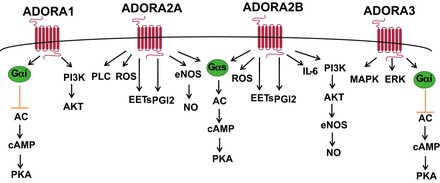Fig. 2.

Adenosine receptor-mediated signaling pathways. Extracellular adenosine functions as signaling molecule by engaging cell surface adenosine receptors (ADORA1, ADORA2A, ADORA2B, and ADORA3). ADORA1 and ADORA3 adenosine receptors are coupled to adenylyl cyclase (AC) by the inhibitory G-protein subunit (Gαi) and thereby can lower intracellular levels of the second messenger cyclic adenosine monophosphate (cAMP). In contrast, the ADORA2A and ADORA2B adenosine receptors can induce AC by the stimulatory G-protein subunit (Gαs) and therefore can induce intracellular cAMP levels. Activation of both ADORA1 and ADORA2B stimulates phosphatidylinositol 3-kinase (PI3K)/AKT pathway, and activation of both ADORA2A and ADORA2B induces release of ROS, EETs, and PGI2. PKA, protein kinase A; PLC, phospholipase C; ROS, reactive oxygen species; EETs, epoxyeicosatrienoic acids; PGI2, prostacyclin; eNOS, endothelial NO synthase; NO, nitric oxide; IL-6, interleukin 6; MAPK, mitogen-activated protein kinases; ERK, extracellular signal-protein kinase.
